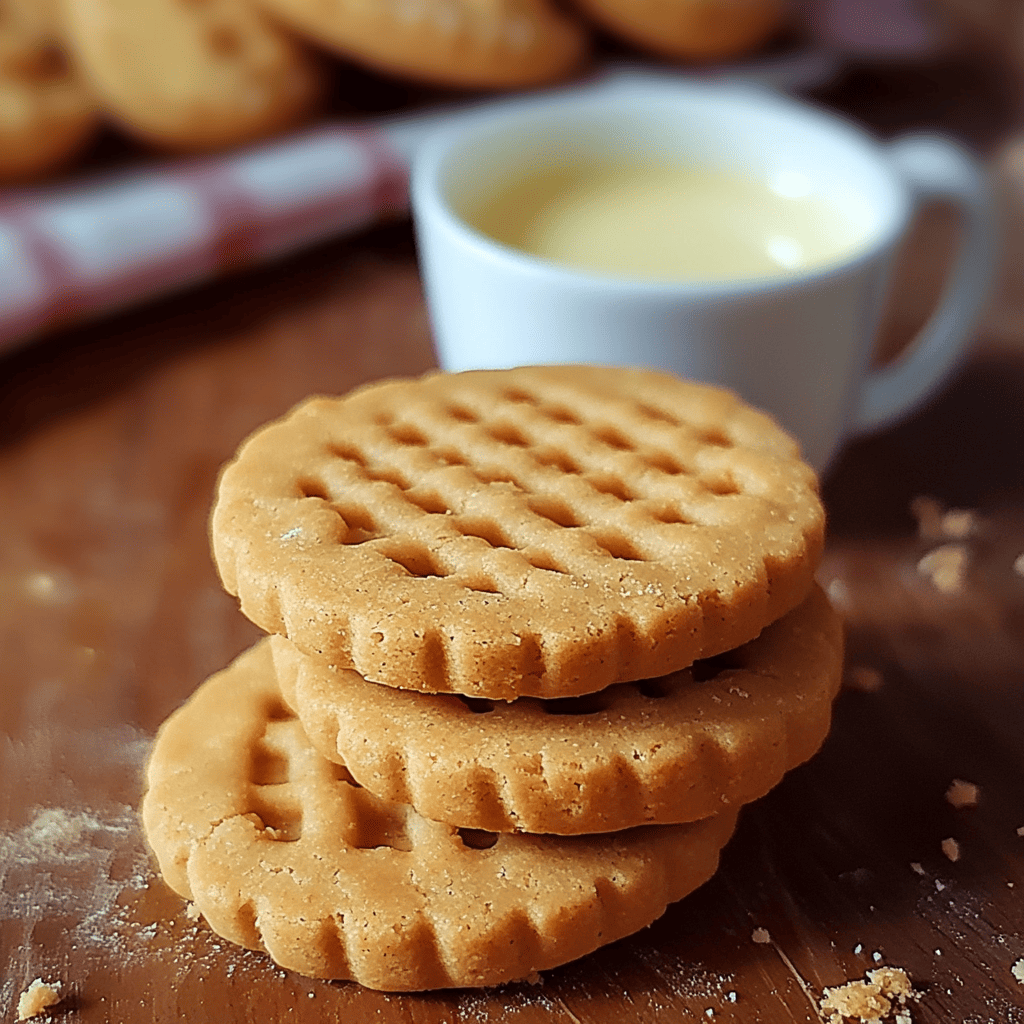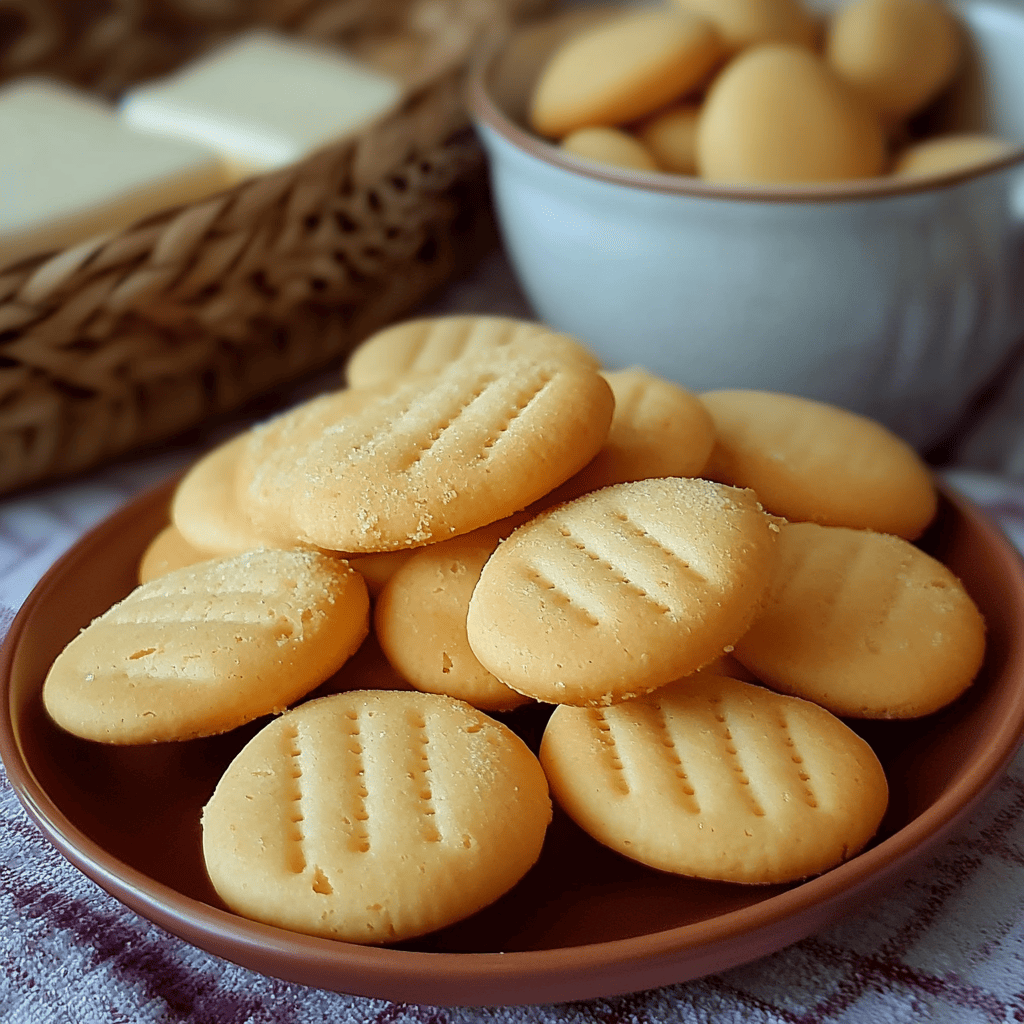Cornstarch Cookies: A Tender Bite That Melts in Your Mouth
Introduction: The Delicacy Made Cookie
Cornstarch Cookies, also known in some places as “Maicenas,” are a classic of homemade baking, appreciated for their incredibly tender texture and gently sweet flavor. Cornstarch, their star ingredient, gives them an almost ethereal quality, making them melt in your mouth with every bite. This recipe, with the addition of eggs, margarine (or butter), milk, and oil, creates a rich and comforting cookie, perfect with coffee, tea, or simply for a sweet treat. Discover all the charms of these delicate cookies!
Detailed History in Spanish: A Legacy of Gentleness and Tradition
The history of cookies made with cornstarch is linked to the popularization of this ingredient in baking. Cornstarch, or cornstarch, is a fine starch obtained from the corn kernel. Its use in cooking spread as its properties for thickening sauces and creams became recognized, and, in the case of baking, for providing a soft and delicate texture to baked goods.
Corn and Cornstarch: Corn is a crop native to the Americas that was domesticated thousands of years ago in Mesoamerica. With the arrival of Europeans in the Americas, corn was introduced to other parts of the world, where it adapted to different climates and became a staple food in many regions. The extraction and processing of cornstarch allowed cooks and bakers to experiment with new textures and consistencies in their preparations.
The Evolution of Soft Cookies: Throughout history, cookies have evolved from simpler, harder preparations to more elaborate, tender varieties. The addition of ingredients such as fats (butter, margarine, oil) and starches (like cornstarch) has allowed for cookies with a softer, more crumbly texture.
No single origin can be pinpointed for cornstarch cookies as we know them today, as similar recipes likely emerged independently in different locations as people experimented with available ingredients. However, their popularity in many regions, especially in Latin America, suggests that they became an important part of the traditional home baking repertoire.
The specific combination of cornstarch with eggs, fat, milk, and sugar creates a dough that, when baked, develops a very delicate structure due to the high proportion of starch and fat, resulting in that characteristic melt-in-the-mouth texture.
More Historical Detail: Regional Influences and Adaptations
Delving into the history of these cookies, we can consider some possible regional influences and adaptations:
- Homemade Baking and Experimentation: Home baking has always been fertile ground for experimentation with ingredients and techniques. Cornstarch cookie recipes likely arose from the need to use readily available ingredients creatively to create delicious and unique desserts.
- The Availability of Cornstarch: As cornstarch became more widely available in homes, its use in baking expanded. Its ability to create smooth textures made it a valuable ingredient for cookies, biscuits, and other baked goods.
- Regional Adaptations: In different countries and regions, variations of this recipe may have developed, with the addition of other ingredients such as citrus zest, vanilla essence, or other flavorings to customize the flavor. Cookie shapes may also vary depending on local traditions.
The “sandy” or “melt-in-the-mouth” texture provided by cornstarch is a highly valued characteristic of certain types of crackers in many cultures. This quality makes them especially pleasant to pair with hot beverages, as they soften slightly and blend perfectly.

Ingredients & Detailed Preparation
Ingredients:
- Eggs: 3 units
- Margarine (or butter): 250 g (At room temperature for easy mixing)
- Milk: 1 cup (American)
- Oil: 1 cup (American) (You can use neutral vegetable oil such as sunflower or corn)
- Sugar: 500 g
- Corn starch (sweet cornstarch): 1 kg
- Baking powder: 1 tablespoon
Detailed Preparation:
- Preheat oven and prepare baking sheets: Preheat oven to a low temperature, around 150°C (300°F). Line baking sheets with parchment paper or baking paper to prevent the cookies from sticking.
- Cream the margarine (or butter) and sugar: In a large bowl, cream the room temperature margarine (or butter) with the sugar until smooth and creamy. You can use an electric mixer or do this by hand with a wooden spoon.
- Add the eggs: Add the eggs one at a time to the margarine and sugar mixture, beating well after each addition to ensure they are fully incorporated.
- Add the milk and oil: Pour the milk and oil into the mixture and whisk until well combined. The mixture may seem a little runny, but that’s normal.
- Stir in the cornstarch and baking powder: In a separate bowl, mix the cornstarch and baking powder. Gradually add this dry mixture to the wet ingredients, beating at low speed or mixing with a spatula until you get a smooth, even batter. The batter will be quite thick.
- Shaping the cookies: You can use several techniques to shape the cookies:
- Using a pastry bag: Place the dough in a pastry bag with a curly or plain nozzle and form small cookies on the prepared trays.
- Scoop: Scoop out portions of dough onto the baking sheets, leaving a little space between each one. You can then lightly press down the center with a fork to create a design.
- Roll out and cut: Dust a flat surface with a little cornstarch and roll out the dough to the desired thickness (not too thin). Cut the cookies into the desired shapes using cookie cutters and place them on the baking sheets.
- Bake: Place the baking sheets in the preheated oven and bake for about 15-20 minutes, or until the cookies are lightly golden brown on the edges and bottom. Baking time may vary depending on the size and thickness of the cookies, as well as the power of your oven. Keep an eye on them to make sure they don’t burn.
- Cooling: Remove the baking sheets from the oven and let the cookies cool completely on the baking sheets before handling, as they are very delicate when warm. Once cool, they will firm up slightly.
- Storage: Store cornstarch crackers in an airtight container at room temperature to maintain their freshness and texture.
Additional Tips
- Ingredient Temperature: Make sure the margarine (or butter) and eggs are at room temperature so they mix more evenly and the batter is smooth.
- Don’t overbake: These cookies tend to dry out if overbaked. Remove them from the oven when they’re lightly browned around the edges.
- Flavor variations: You can add lemon or orange zest, vanilla essence, or even a little cinnamon to the dough to vary the flavor.
- Decoration: Once cooled, you can dust the cookies with powdered sugar for a sweeter and more attractive presentation. You can also dip them in melted chocolate or join them together in pairs with a dulce de leche, jam, or cream filling.
- Extra tender texture: For an even more tender texture, you can substitute some of the cornstarch with rice flour.

Frequently Asked Questions and Estimated Preparation Time
- Can I use just butter instead of margarine and oil? Yes, you can use 250g of butter instead of margarine and oil. The final texture may vary slightly, perhaps being a little less tender, but they will still be delicious.
- Why was my dough too runny? The dough for these cookies tends to be on the thick side. If it’s too runny, there may have been a mistake in the ingredient measurements. Make sure you’re using standard American measuring cups.
- How long do these cookies last? Properly stored in an airtight container, cornstarch cookies can last up to a week without losing their texture.
Estimated Preparation Time:
- Preparation: 25-30 minutes (measure ingredients, beat the dough)
- Baking: 15-20 minutes per batch of cookies
- Cooling: 20-30 minutes
- Total time: Approximately 1 hour – 1 hour and 20 minutes (depending on the number of rounds)
Texture and Flavor
The texture is the star feature of these cookies. They’re incredibly tender, almost sandy, and melt in your mouth at the first bite. The cornstarch is responsible for this delicacy, creating a soft and pleasant sensation on the palate.
The flavor is gently sweet, with a light milky note and a neutral background that allows you to appreciate the texture. Adding aromas like vanilla or citrus fruits blends delicately into the cookie’s overall flavor. They’re not overly sweet, making them perfect for pairing with drinks or enjoying on their own without being overpowering.
Consumer Context
Cornstarch Cookies are ideal for various occasions:
- Accompanying hot drinks: They are perfect for dipping in coffee, tea, milk, or hot chocolate, as their tender texture softens them even further.
- Light snack: They are an excellent option for a light and sweet snack at any time of day.
- Light dessert: They can be served as a simple dessert after a meal, especially if decorated or filled.
- For children: Their soft texture makes them very pleasant for small children.
- Homemade Gift: Presented in a pretty box, they are a sweet and personal gift.
Visual Aspect
Cornstarch cookies are usually pale yellow or light golden in color after baking. Their surface may be smooth or show fork marks if pressed before baking. If piped, they may have ruffled or decorative shapes. Their overall appearance is delicate and soft, suggesting their tender texture. Dusted with powdered sugar, they take on an even sweeter and more appealing appearance.
Curiosities
- The power of cornstarch: Cornstarch is a pure starch that, when baked, absorbs moisture and contributes to the tender, crumbly texture of cookies.
- Name variations: In different Spanish-speaking countries, these cookies can be called differently, with “Maicenas” being one of the most common.
- A timeless classic: Despite being a simple recipe, cornstarch cookies have endured over time as a favorite among many families.
Nutritional Value (Estimated per Serving – 2 small cookies)
Please note that these values are approximate and may vary depending on the size of the cookies and the exact amounts of ingredients used.
- Calories: 120-150 kcal
- Protein: 1-2 g
- Fat: 8-10 g (depending on the type of fat used)
- Saturated fat: 2-4 g (if butter or margarine is used)
- Carbohydrates: 15-20 g (mainly from corn starch and sugar)
- Sugars: 8-10 g
- Fiber: Less than 1 g
- Sodium: Variable (depending on whether salt is added)
Additional Benefits and Interesting Facts
- Suitable for people with gluten sensitivity (when using pure cornstarch): Cornstarch is naturally gluten-free, so these cookies can be an option for people with gluten sensitivity, as long as you ensure there is no cross-contamination of ingredients.
- Easy to digest: Their tender texture and mild ingredients make them easy to digest.
- Versatile base: Its mild flavor allows it to be combined with a variety of accompaniments and fillings.
Other Information
- Storage: It is important to store these cookies in an airtight container to prevent them from absorbing moisture from the environment and losing their tender texture.
- Gift Presentation: Placed in a decorative box or cellophane bag tied with a bow, they make a much-appreciated homemade gift.

Conclusion: A Sweet and Tender Hug in Every Bite
Cornstarch Cookies are much more than a simple cookie; they’re a sensorial experience that evokes the warmth of home and the pleasure of simple, well-made flavors. Their melt-in-the-mouth texture and gently sweet flavor make them a comforting and delicious treat for any occasion. Whether pairing with your favorite beverage, enjoying a delicate snack, or sharing a sweet treat, these cookies are a surefire choice that will always leave a soft and sweet feeling. Go ahead and bake them and enjoy this marvel of homemade baking!

